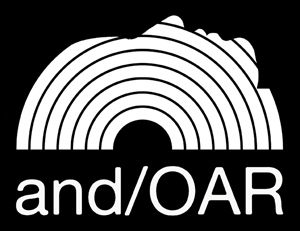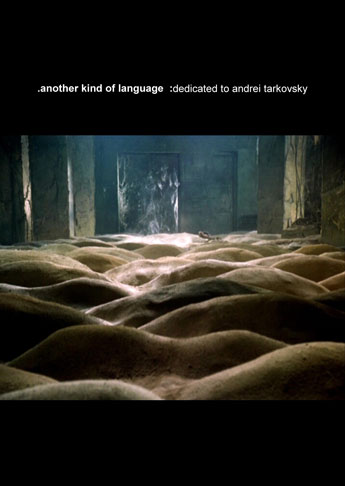Track List:
Disc 1:
01. mnortham: When Inaccessible
02. Jon Tulchin: Mnemonic Cartography
03. Yannick Dauby: Bruissements
04. Dale Lloyd: Smoldering Ardor
05. John Hudak: In The Dream
06. Kiyoshi Mizutani: Nicholai
Disc 2:
01. rsundin: Spegeln
02. v. v.: We Were Young
03. Magali Babin: At The End Of The Rope
04. duul_drv: Staring Into The Field, Waiting, Travelling, Listening
05. Josh Russell: Objects
06. Phillip Pietruschka: Recondite Geometry
07. Sawako: Mirror
08. Logoplasm: Sacrifice
Fourteen sound artists created pieces inspired by one of Tarkovsky's seven
feature length films. They were given creative carte blanche as to how they
would pay homage to one of the director's films. Some pieces are less direct
than others, and were created with the intent to also pay homage to the
director's work as a whole or to certain aspects thereof.
Liner note text by Kim Cascone & Trond Trondsen of Nostalghia.com.
"...nothing short of wonderful! I am an experimental filmmaker who has been
inspired by Tarkovsky as well as other European filmmakers -- a collection of
this sort is a salve for the weary spirit. There's nothing quite like dreaming
while being awake; these pieces are powerful in their simplicity -- they fire my
imagination.
I congratulate you and the other artists and crew who were involved with this
project. Job well done!" (Patrick Steele - Fatcat Filmworks)
Reviews
_________________________________________________________________________________
E / I Magazine (October 2005)
Russian filmmaker Andrei Tarkovsky’s rep hasn’t exactly set the mainstream
director’s guild on fire these last 20 years, but it’s fairly ignited the
audio/visual underground in ways yet to be calculated. Dale Lloyd’s world
has been singed pretty seriously; the concept of phonography (the merging
of those a/v sensibilities, acquiring and recontextualizing the abject notions
of sound design and cinematography) on which his label and/OAR is built, is
about as perfect a marriage to the Tarkovsky ethic as one could imagine.
That brings us to the label’s two-disc comp dedicated to the director, Another
Kind of Language, whose resident 14 artists focus their own mental lens’ on
Tarkovsky’s isolationist panoramas. Focus they do: the parallels drawn are
markedly impressionistic, as they should be, and folks like John Hudak,
Magali Babin, Yannick Dauby and Lloyd himself are far too resourceful to
sensationalize literally the inherent power of such Tarkovsky classics as
Stalker and Solaris. So Hudak exteriorizes the cries of birds in husks of
blasted radioactive trees; Dauby navigates his way through the hum of
machinery set adrift in orbit; Rsundin and Logoplasm lose their protagonists
in spatial waves of electrostatic discharge. Snatches of dialog occasionally
provide “samplist links” but the participants’s reactions are causal to a fault
— each track, “composed” or not, demonstrates genuine inspiration
precisely because the aural responses are so intuitively reactionary. Wet,
dark and long, and intermittently brilliant, Language raises the awareness
level on a network whose octopusic reach continues to gnaw away at the
artistically discrete smarm of the bourgeoisie. (Maxwell Oz)
Zehar (May 2004)
Ez da hilabete aunitz pasatu lagun baten bidez Andei Tarkovskyren
Nostalghia filma ikusi ahal izan nuela. Geroztik, harekin gogoratzerakoan,
irudi bakarra dut gogoan. Pertsonaia nagusia, kandela eskuan, erakusten
duen travelling amaigabea. Hutsa bezain betea den irudia. Ixila bezain
ozena. Orduan ulertu nuen zer den hizkuntza berri bat sortzea, bertzelako
hizkuntza bat sortzea. Andrei Tarkovsky (1932-1986) zinemagile errusiarrak
utzitako ondareak zinemaren historian egin den artelan eder eta
garrantzitsuenetako bat izatea lortu badu ere, argi dago, gaurko egunetik
ikusita behintzat, ez duela ikusle gehienen onespena izan. Baina bere
oinstzek, bere arrastoek tinko irauten dute oraindik artegintzaren bide
bazterran, eta ez bakariik zinemagintzaren munduan. and/OAR label
diskografiko iparramerikarrak hori izan du xede, musika lan eder hau
osatzerakoan, alde batetik, errusiarraren lana omentzeko eta bertzetik, haren
ondarearen inguruan hausnarketa egiteko. Ederra, kontzeptuan nahiz
exekuzioan, lan honek, izenburu beretik hasita, zinemagile errusiarrak bere
lanen bitartez lortu zuen gauza ederrenetako bati egiten dio erreferentzia,
artearen bitartez hizkuntza berri bat asmatzeari, hain zuzen. Zentzu horretan,
Tarkovsky, zinemaren legez, ahalmen hori irudien bitartez islatzeko gai izan
bazen, aipatzekoak dira soinuaren edo musikaren inguruan egindako
erabilerak eta horrek aldi berean bere diskurtsoa osatzeko erakutsitako
gaitasuna. Horregatik, solasgai dugun bilduman, musika elektronikoa izan
da errusiarraren lana omentzeko aukeratutako prisma, bertzeak bertze
musika mota honekin egin zuen lana aitzindaria ere izan baitzen.
"Musika elektronikoa sumatzen dugun momentu berean, alegia, bere
egitura nolakao den ulertzen dugun momentu horretan bertan desagertzeko
gai da. Musika instrumentala berriz, hain da arte independentea, ezen film
batean sartzeko aise zailagoa bihurtzen baita, eta film beraren zati
organiko bihurtzen da."
Tarkovskyren premisa hauek ez daude gaur egungo musika elektroniko
esperimentalaren eta minimalistaren filosofiatik hain urrun (sortzaile guztiak
batzeko gai den filosofiaraik badago), lan hau osatzen duten artista
gehienen kasuan, behintzat. Paisajista sonoroen, elektroakustikaren eta
soinu esperimentazio ororen ondorengoak, azken hamarkadotan hainbat
musikarik hiztegi berri bezain ezaguna erabiliz, argi eta garbi erakutsi du
hizkuntza berriak bilatzeko grina, Francisco Lopez, horren adibide. Disko
bikoitz honetan bada, orain aipatutakoaren 14 adibide biltzen dira,
nazioarteko 14 artista, bakoitza Tarkovskyren film batean oinarritu baino
inspiratuta, 14 pieza osatu dituztenak. Bakoitzak bere modura egin dio
erreferentzia filmei: batzuek esplizituki filmeko momentuak soinu bidez (inoiz
ez hitz eginez) iradoki dituzte, eta bertze batzuek, berriz, zuzenean filmen
bidez jasotako inpresio edo bizipenetan oinarritutako piezak osatu dituzte.
Haien artean aipatzekoak dira, beharbada filmetako sentsazioak iradokitzeko
gaitasuna dela eta, Michael Northam eta Dale Lloyd Amerikarren, duul_drv
Kanadiarraren edo logoplasm talde Italiarraren saiakera zoragarriak. Atal
entzungarriaz gain, Kim Casconeren (ikus Zehar 51), eta zinemagile
errusiarra omentzen duen www.nostalghia.com web orriko arduraduna den
Trond S. Trondsonen testu mamitsuek, zenbait zita tartean, osatzen dute,
dudarik gabe, maitasun haundiz egindako lan eder hau.
"Soinu tonua ezbai batean mantendu behar da, entzuten duguna musika,
ahots bat edo haizea izan daitekeenean." (Xabier Erkizia)
Igloo (April 2004)
It was only a few months ago that I reviewed "In Memoriam Tarkovsky" (on
Russian label IVB) another homage to the influential filmmaker who passed
in 1986. Several interesting artists pack this two-disc set, packaged in a
cinematic DVD-style case with 14 long playing tracks. Opening the set is
Mnortham's inclement "When Inaccessible." At over fifteen minutes, the field
recordings of steep rainfall meet the atypical sine drone of a tuning fork (or
so it sounds). The hush wind tone of Jon Tulchin's "Mnemonic Cartography"
uses a collection of sparse sound samples of nature: the crackle of campfire
(or is it the sizzle of bacon?), the top wind on the ocean's edge, and the eerie
void of the midnight air with a moon halo. He stops to take breathy pauses
as metal is towed and muffled timbre cascades with sluggish pace. Yannick
Dauby's "Bruissements (for Solaris: Tarkovski/Lem)" reminds me of some of
his previous work with crackling embers and other experiments in gently
stirring sound demographics. The theme continues with "Smoldering Ardor"
by label maestro Dale Lloyd. The tactile environment is steely as stubbly
miniature clicks drag our ears through the dirty hum of a convincing whispery
world. Towards the end, what could be a stampede of horses is a windswept
distortion of open flames. Birds whistle and call "In the Dream" of John
Hudak. Subtitled "Tarkovski's Sacrifice", the normally resplendent chirp-chirp
has a somewhat menacing edge on this 21+ minute piece. He's tuned
these feathered friends into something of a channeled set of harmonic
scales, almost as if they are pets on command. Left to right, simultaneous,
and fore / background - these sing-song short calls for attention balance a
calm and unnerving energy. Kiyoshi Mizutani's unscripted percussive chant
"Nicolai", sounds like a group of monks in a subway. He portions out parts of
this track - the first with street sounds vs. some passing airborne calling
birds (the theme is alive and well). Next are some gravel-like pouring from
left to right channel, add an open canvas of rain, a random singing choir and
it becomes a bit like r.e.m. to me - and I don't mean the band. This is an
illusory open-air bath for the sensual pleasures of the wild. Towards its
conclusion, a plane takes flight, above and away.
Disc two opens with Sweden's Rsundin whose "Spegeln" is a sudden clap
of thunder and roaring lightening, and we are in a surround-sound live storm
with a sweet robin calling to it's family. The lapping waves and gulls envision
a shore after the eye of the storm has firmly closed, some remnants left
aside. "At The End Of The Rope" is Magali Babin's fuzzy contribution.
Crumbling stagecoaches, rattling teeth and the bass of pain/pleasure
moaning from a headless figure in the deep background. Canadian artist S.
Arden Hill, otherwise known as duul_drv breaks the sound barrier with a
popping glass bulb and various metallic industrial bric-a-brac. His
harmonies are woven texturally and sequenced like fine layers of Egyptian
silks. Josh Russell spends 18 minutes forming his "Objects" with space
light and secret lasers (I made that part up - but that's what it sounds like).
It's as if you are dealing with sensitive infrared technology, everything is so
mute with a layer of impending challenge to the risky material. 24-year old
Tokyo-based Sawako (Kato) develops her sound from small fragments,
amplified and then processed, the equivalent of refried beans in electronics.
The process of reduction makes her "Mirror" reflect only the residue of
nature's work. It's like an organic inversion, simply shrunk and mixed with
floating physical manifestations of sound particles moving about, kicking
along a metallic perimeter.
Included are liner notes with various quips and statements by Arvo Part,
Ingrid Bergman, and Kim Cascone's apropos "Viral Space: The Cinema Of
Atmosphere." With additional tracks by logoplasm, Phillip Pietruschka, and
v. v. this is essential listening for any lover of cinema and various
experiments with sounds that are born in the wild. (TJ Norris)
Aquarius Records (February 2004)
Despite the oversized package and the dedication to the amazing Russian
filmmaker Andrei Tarkovsky, this is not a DVD. Rather this is a collection of
sound artists and archivists who were commissioned to create a piece
inspired by the work of Tarkovsky. The majority of the artists in question have
composed their pieces as an homage to Tarkovsky's slow, but revelatory
pacing of the narrative. The atmospheres of the sublime, the psychologically
horrific, and the melancholic -- which all run through Tarkovsky's work --
speak boldly with Another Kind Of Language as thick dronescapes molded
from various field recordings of rain, wind, and surf. There isn't anything overt
about this comp that screams out "TARKOVSKY!" with no obvious samples
or quotations to be found within; rather, this is a humble dronological tribute
to the Russian filmmaker's amazing sensibilities. The contributing artists run
the gamut, from familiar AQ faves MNortham, John Hudak, and Kiyoshi
Mizutani, to lesser-knowns/unknowns Jon Tulchin, Yannick Dauby, Dale
Lloyd, RSundin, V.V. Magali Babin, Duul_Drv, Josh Russell, Phillip
Pietruschka, Sawako, and Logoplasm.











Artist: Various Artists
Title: Another Kind Of Language - Dedicated To Andrei Tarkovsky
Catalog Number: and/10
Release Year: 2003 / 2004
Format: CDR x 2
Status: sold out / a revised triple CD edition was issued in 2015



